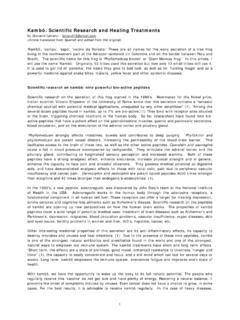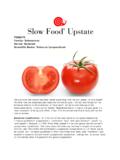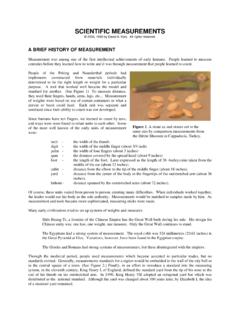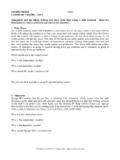Transcription of SOIL REGIONS OF ITALY - soilmaps.it
1 RomeBariAostaTurinGenoaMilanAnconaNaples TrentoVeniceL'AquilaPerugiaTriesteBolzan oBolognePotenzaPalermoFlorenceCagliari 0200400100 KilometersSOIL REGIONS OF ITALYI talian National Council for Agricultural ResearchItalian National Center forSoil MappingExperimental Institute for soil Study and Ministry of AgriculturePolicies and ForestrySOIL REGIONS OF ITALY Edoardo A. C. Costantini, Ferdinando Urbano, Giovanni L Abate The soil region data base, scaled 1:5,000,000, is the first informative level for the soil map of ITALY and, as the same time, is the tool for soil correlation at the continental level. soil REGIONS are a regionally restricted part of the soil cover characterized by a typical climate and parent material association. The description of the main soil degradation processes, according to their occurrence in the different soil REGIONS , instead of administrative REGIONS , permits to take into account local specificity and, at the same time, to avoid redundancies.
2 The soil REGIONS database was matched with the Corine land cover and the soil national database, which is maintained by the Italian National Center for soil Mapping, part of the Experimental Institute for soil Study and Conservation, to appreciate specific soil characteristics. soil REGIONS of the Italian alluvial and coastal plains, and associated low hills Po plain and moraine hills of Piedmont and Lombardy Surface: 49546 km2, of ITALY . Climate and pedoclimate: temperate-suboceanic; in coastal areas: warm-temperate-oceanic and suboceanic, partly submediterranean; mean annual air temperature: 11-13 C; mean annual precipitations: 690-1200 mm; rainiest months: May and October; dry months: July and August; months with mean temperatures under 0 C: January, no one in the areas near the coast. soil moisture regime: udic and subordinately ustic, locally xeric; temperature regime: mesic and subordinately thermic.
3 Geology and morphology: Quaternary alluvial and glacio-fluvial deposits. Level land, mean altitude: 95 meters above sea level (standard deviation 110), mean slope: 1% (std 5). Main soils: soils with pedogenetic structure in depth and weakly differentiated profile (Eutric, Chromic and Calcaric Cambisols); recent alluvial soils (Eutric and Calcaric Fluvisols); soils with reorganization of carbonates (Haplic Calcisols); soils decarbonated and rich in iron oxides, with clay accumulation along the profile (Haplic, Gleyic and Chromic Luvisol); sandy and weakly developed soils (Calcaric Arenosols and Regosols); soils with vertic properties and reorganization of carbonates (Gleyic and Vertic Cambisols, Eutric, Gypsic and Calcic Vertisols); more or less shallow soils on limestone with organic matter accumulation (Rendzic Leptosols; Calcaric Phaeozems); soils with shallow water table (Eutric Gleysols; Thionic Fluvisols and Cambisols); soils with organic matter accumulation (Ombric and Thionic Histosols).
4 Main land capability classes: 1st and 2nd class soils, with local limitations for acidity, stoniness, water excess, clayey texture, peat. Main soil degradation processes: the high potential agricultural productivity of soils conflicts with the other kinds of utilization, which have been steadily occupying the territory during the last decades. Some of the soil region is now occupied by extra-agricultural uses (urban areas, industrial settlements, quarries, infrastructures, etc.) with maximum concentration in the high plain, , and on moraine hills, of the surface. soil are generally fertile, although often poor in organic matter. The intensive agricultural use ( of the surface is utilized as row and close-grown crops and only as meadow or woodland) can cause degradation of soil physical and chemical condition, as well as groundwater contamination, especially where the organic matter and pH are low or very low (western part of the soil region).
5 The groundwater pollution risk is particularly high in irrigated land ( of the soil region, concentrated in the medium and high plain) especially in rice cultivated lands (western part of the soil region), and in the recently reclaimed territories of the eastern part. The soil region is covered for to by water bodies, which are more widespread near the Po delta. In the recently reclaimed area, subsidence is still taking place, and an increase in the diffusion of soil salinization has been signalled. Versilia and internal plains of Tuscany, Umbria and Lazio Surface: 5223 km2, of ITALY . Climate and pedoclimate: Mediterranean oceanic and suboceanic; mean annual air temperature: 12-15 C; mean annual precipitation: 850-1100 mm; rainiest months: October and November; dry months: July and August; months with mean temperatures under 0 C: no one. Dominant soil moisture and temperature regime: udic, thermic.
6 Geology and morphology: Quaternary alluvial and lacustrine deposits. Mainly level land, mean altitude: 184 meters (std 145), mean slope: 4% (std 9). Main soils: alluvial soils, with shallow water table and organic matter accumulation (Eutric Gleysols, Fluvisols and Cambisols; Ombric Histosols); weak vertic properties (Vertic Cambisols); decarbonated soils, rich in iron oxides, with clay accumulation along the profile (Haplic, Chromic and Gleyic Luvisols). Main land capability classes: 1st, 2nd and 5th class soils, with limitations for flood risk, water excess, clayey texture, locally for acidity, stoniness, salinity or peat. Main soil degradation processes: also this soil region shows an high conflict between different land uses. Row and close-grown crops cover some of the area, while urban areas, quarries, refuse heaps and other extra-agriculture uses cover to ; the presence of woodlands and meadow however is not negligible, that is , somehow linked to the presence of water bodies (3% of the soil region) and acid paleosols.
7 Degradation of soil physical quality (namely compaction) has been indicated in many places and attributed to the intensive agricultural exploitation and to the low soil organic matter content. Coastal plains of central ITALY and included hills Surface: 4985 km2, of ITALY . Climate and pedoclimate: Mediterranean to subcontinental and continental; mean annual air temperature: 14-17 C; mean annual precipitations: 620-1000 mm; rainiest months: October and December; dry months: June, July and August; months with mean temperatures under 0 C: no one. soil moisture and temperature regime: xeric, thermic. Geology and morphology: Quaternary alluvial deposits with inclusions of Tertiary metamorphic rocks. Level land, mean altitude: 76 meters (std 99), mean slope: 7% (std 12). Main soils: alluvial soils, sometimes with shallow water table (Calcaric Cambisols, Fluvisols and Gleysols); soils with clay accumulation along the profile (Chromic, Calcic, Gleyic, Haplic and Vertic Luvisols); soils with vertic properties and reorganization of carbonates (Vertic Cambisols; Eutric, Calcaric and Calcic Vertisols), saline soils (Solonchaks).
8 Main land capability classes: 1st, 2nd and 5th class soils in plane, with limitations for water excess, clayey texture, drought, locally for acidity; 4th, 6th and 7th class soils on hills, for stoniness, rockiness, slope and acidity. Main soil degradation processes: the region is mainly utilized with row and close-grown crops (around 50% of the total surface) which are widespread in the plains, while hills are mainly covered by forest and meadows (around 25% of the region). The most important soil degradation processes are here attributed to the competition between agricultural and not-agricultural uses of water. The competition is due to the scarcity of water bodies (only 1% of the region) and to the dry Mediterranean climate, and it is particularly harsh in the plains, where settlement are concentrated ( of the region is covered by not-agricultural uses). As to consequence, localized, but severe soil degradation phenomena are claimed, due to the use of brackish waters.
9 In addition, relevant phenomena of groundwater pollution are signalled in the intensively cultivated plains of the southernmost part of the region. Capitanata and plains of Metaponto, Taranto and Brindisi Surface: 6377 km2, of ITALY . Climate and pedoclimate: Mediterranean subtropical; mean annual air temperature: 12-17 C; mean annual precipitation: 400-800 mm; rainiest months: October and November; dry months: May to September; months with mean temperatures under 0 C: no one. soil moisture and temperature regime: xeric and dry xeric, thermic. Geology and morphology: Quaternary alluvial and marine deposits mainly clay and loam, with hollow limestone. Level land, mean altitude: 101 meters (std 93), mean slope: 3% (std 5). Kilometers 0300600150 soil Main soils: soils with vertic properties and reorganization of carbonates (Calcic Vertisols; Vertic, Calcaric and Gleyic Cambisols; Chromic and Calcic Luvisols; Haplic Calcisols); alluvial soils (Eutric Fluvisols), saline soils (Solonchaks).
10 Main land capability classes: 1st, 2nd and 3rd class soils, with limitations for clayey texture, stoniness, drought and salinity. Main soil degradation processes: soil degradation processes due to competition between agricultural and not-agricultural uses of water are here made stronger because the even drier Mediterranean climate and the more intense urbanization. Evidences of localized soil alcalinization, besides salinization, are reported. Campidano and plains of Sulcis and central Sardinia Surface: 2493 km2, of ITALY . Climate and pedoclimate: Mediterranean subtropical; mean annual air temperature: 16-18 C; mean annual precipitation: 400-800 mm; rainiest months: November and December; dry months: June to September; months with mean temperatures under 0 C: no one. soil moisture and temperature regime: dry xeric and thermic. Geology and morphology: Quaternary alluvial deposits.





